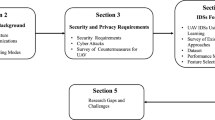Abstract
The proliferation of Unmanned Aerial Vehicles (UAVs) brings about many new security concerns. A common concern with UAV security is for an intruder to take control of a UAV, which leads for a need for a real time anomaly detection system. This research resulted in a prototype UAV monitoring system that captures flight data, and then performs real time estimation and tracking of the airframe and controller parameters. The aforementioned is done by utilizing the Recursive Least Squares Method (RLSM). Using statistical validation and trend analysis, parameter estimates are critical for the detection of cyber attacks and incipient hardware failures that can invariably jeopardize mission success. The results demonstrate that achieving efficient anomaly detection during flight is possible through the application of statistical methods to profile system behavior. The anomaly detection system that was designed can be performed in real time while the UAV is in flight, constantly verifying its parameters.
Similar content being viewed by others
Explore related subjects
Discover the latest articles, news and stories from top researchers in related subjects.References
Amazon Prime Air http://www.amazon.com/b?node=8037720011, accessed on 13 Feb 2014
UAV Roundup 2013 http://www.aerospaceamerica.org/Documents/AerospaceAmerica-PDFs-2013/July-August-2013/UAVRoundup2013t-AA-Jul-Aug2013.pdf, accessed on 13 Feb 2014
Federal Aviation Administration selects Rutgers for drone research program. http://www.dailytargum.com/news/federal-aviation-administration-selects-rutgers-for-drone-research-program/article_403dc68a-7888-11e3-a0c2-0019bb30f31a.html, accessed on 13 Feb 2014
Unmanned Aircraft Systems: PercePtions & Potential, http://www.aia-aerospace.org/assets/AIA_UAS_Report_small.pdf, accessed on 13 Feb 2014
FAA Selects Six Sites for Unmanned Aircraft Research. http://www.faa.gov/mobile/index.cfm?event=news.read&update=75399, accessed on 13 Feb 2014
Rawnsley, A.: Iran’s alleged drone hack: tough, but possible, http://www.wired.com/dangerroom/2011/12/iran-drone-hack-gps, accessed on 13 Feb 2014
Gorman, S., Dreazen, Y.J., Cole, August: Insurgents hack US drones, The Wall Street Journal 17. Dow Jones and Company, Inc (2009)
Case Study: Rockwell Collins demonstrates damage tolerant flight controls and autonomous landing capabilities. http://www.rockwellcollins.com/sitecore/content/Data/Success_Stories/DARPA_Damage_Tolerance.aspx, accessed on 13 Feb 2014
Nguyen, N.T., Krishnakumar, K.: Hybrid intelligent flight control with adaptive learning parameter estimation. J. Aerosp. Comput. Inf. Commun. 6(3), 171–186 (2009)
http://www.nytimes.com/2014/01/15/us/nsa-effort-pries-open-computers-not-connected-to-internet.html?_r=1, accessed on 13 Feb 2014
Shepard, D.P., et al.: Evaluation of smart grid and civilian UAV vulnerability to GPS spoofing attacks. In: Proceedings of the ION GNSS Meeting (2012)
SkyJack: Hacker-drone that can wirelessly hijack & control other drones. http://rt.com/news/hacker-drone-aircraft-parrot-704/, accessed on 13 Feb 2014
Nilsson, D.K., Larson, U.: A defense-in-depth approach to securing the wireless vehicle infrastructure. Journal of Networks 4(7), 552–564
Javaid, A.Y., Sun, W., Devabhaktuni, V.K., Alam, M.: Cyber security threat analysis and modeling of an unmanned aerial vehicle system. In: 2012 IEEE Conference on Technologies for Homeland Security (HST). 13-15 Nov, p 585,590 (2012)
Spripada, N.R., Fisher, D.G.: Improved least squares identification. Int. J. Control. 46(6), 1889–1913 (1987)
Siouris, G.M.: Missile Guidance and Control Systems. Springer (2004)
Freeman, P.: Model-Based and Data-Driven Fault Detection Performance for a Small UAV. IEEE/ASME Trans. on Mechatronics 18(4), 1300–1309 (2013). doi:10.1109/TMECH.2013.2258678
Mitchell, R., Chen, I.: Adaptive intrusion detection of malicious unmanned air vehicles using behavior rule specifications. IEEE Transactions on Systems, Man, and Cybernetics: Systems 44(5), 593–604 (2013). doi:10.1109/TSMC.2013.2265083
Goppert, J., et al.: Numerical analysis of cyberattacks on unmanned aerial systems. In: in Infrotech@Aerospace 2012, Garden Grove, California, 2012
Keller, J.D., et al.: Aircraft flight envelope determination using upset detection and physical modeling methods. In: AIAA Guidance, Navigation, and Control Conference, Chicago, Illinois (2009)
Tang, L., et al.: Methodologies for adaptive flight envelope estimation and protection. In: AIAA Guidance, Navigation, and Control Conference, Chicago,Illinois (2009)
Author information
Authors and Affiliations
Corresponding author
Rights and permissions
About this article
Cite this article
Birnbaum, Z., Dolgikh, A., Skormin, V. et al. Unmanned Aerial Vehicle Security Using Recursive Parameter Estimation. J Intell Robot Syst 84, 107–120 (2016). https://doi.org/10.1007/s10846-015-0284-1
Received:
Accepted:
Published:
Issue Date:
DOI: https://doi.org/10.1007/s10846-015-0284-1




